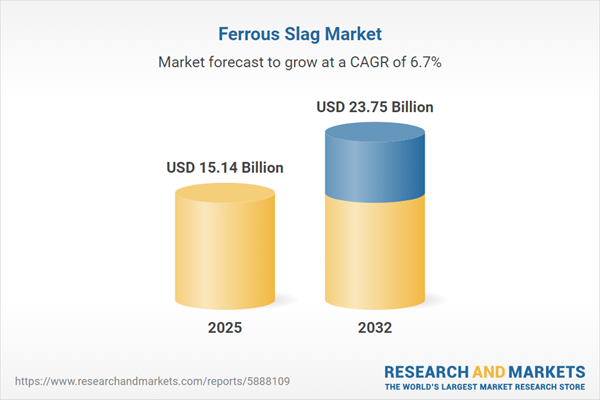Speak directly to the analyst to clarify any post sales queries you may have.
Senior decision-makers focused on achieving both sustainability and regulatory progress in industrial markets are utilizing the ferrous slag market as a strategic enabler. This sector aligns operational goals with compliance demands, supporting adaptive strategies that address emerging environmental and stakeholder priorities.
Market Snapshot: Ferrous Slag Market Industry Growth & Investment Outlook
The global ferrous slag market is valued at USD 14.17 billion in 2024. Growth is expected to reach USD 15.14 billion by 2025 and USD 23.75 billion by 2032, reflecting increasing demand from organizations that prioritize sustainable construction and regulatory compliance. The market’s momentum is shaped by adoption of processing technologies that drive efficiency, support adaptive procurement strategies, and enable organizations to respond rapidly to both regulatory changes and evolving operational requirements. These trends are empowering executive leaders to build resilience and long-term value within their commercial strategies, reinforcing strong positioning in the ferrous slag market.
Scope & Segmentation: Strategic Areas in the Ferrous Slag Market
- Product Types: Blast furnace slag (including air-cooled and granulated forms) and steel slag from basic oxygen and electric arc furnaces—these products offer scalable procurement options aligned with a range of industrial applications.
- Industrial Applications: Used as a soil improver, cement additive, and base material for infrastructure projects, ferrous slag enables organizations to enhance project durability and comply with stringent environmental and quality requirements.
- Distribution Channels: Direct sourcing and distributor partnerships provide flexible logistics solutions, strengthening supply chain reliability for projects from local to international in scale.
- Material Forms: Crushed and granulated ferrous slag variants allow for process optimization in manufacturing and construction, helping organizations tailor their material use to specific sustainability and operational targets.
- Geographic Reach: Market coverage spans the Americas, Europe, Middle East and Africa, and Asia-Pacific, with key markets such as the United States, Canada, Brazil, Germany, China, India, and South Korea benefitting from approaches adjusted to local business and regulatory conditions.
- Market Leaders: Major participants—including China Baowu Steel Group, ArcelorMittal, Nippon Steel Corporation, HBIS Group, POSCO, Jiangsu Shagang, Shougang, Tata Steel, JFE Steel, and Ansteel Group—are advancing recycling, digital processing, and supply chain resilience to foster sustainable market growth.
Key Takeaways: Strategic Insights for Senior Decision-Makers
- Integrating ferrous slag into operations supports sustainability goals, resource reuse, and value-chain efficiency by minimizing waste and boosting project lifecycle performance.
- Adapting procurement strategies to keep pace with changing compliance demands enables responsible sourcing and dynamic compliance management to manage business risks.
- Analytics and predictive technologies support the identification of operational improvements, enhance visibility into risk, and facilitate continuous process optimization.
- Regional market dynamics such as robust infrastructure development in Asia-Pacific and regulatory agility in Europe sustain sector growth and incentivize operational improvements.
- Cooperation between the steel and cement sectors increases supply chain reliability and adaptability, smoothing responses to changing market and regulatory landscapes.
- Ongoing technological advancements enhance risk management and equip organizations to remain resilient as regulations and stakeholder expectations evolve.
Tariff Impact: 2025 U.S. Measures Reshape Global Flows
Forthcoming U.S. tariffs scheduled for 2025 are prompting market participants to reassess sourcing models and deepen domestic partnerships. Investments in local processing facilities are affecting supplier roles and contractual terms, focusing efforts on building domestic supply networks. These steps help organizations reduce supply chain disruptions and strengthen procurement planning as regulatory scenarios evolve.
Methodology & Data Sources
This analysis utilizes a mixed-methods approach that includes in-depth regulatory review, interviews with industry experts, benchmarking, and scenario planning. SWOT analysis underpins the comprehensive evaluation of sector risks and opportunities, arming leadership with practical, evidence-backed guidance.
Why This Report Matters
- Enables procurement and investment decisions that match the pace of regulatory evolution, using actionable analytics to secure a competitive edge in the ferrous slag sector.
- Details regional strategies and benchmarking insights, giving executive teams the tools to target value creation and focused market development in priority geographies.
- Equips organizations to strengthen operational resilience, advance strategic partnerships, and anticipate changes in regulatory and stakeholder requirements.
Conclusion
Comprehensive market intelligence and strategic insights in the ferrous slag sector empower executive teams to achieve compliance, enhance supply chain stability, and ensure business growth amid changing regulatory and resource landscapes.
Additional Product Information:
- Purchase of this report includes 1 year online access with quarterly updates.
- This report can be updated on request. Please contact our Customer Experience team using the Ask a Question widget on our website.
Table of Contents
3. Executive Summary
4. Market Overview
7. Cumulative Impact of Artificial Intelligence 2025
Companies Mentioned
The companies profiled in this Ferrous Slag market report include:- China Baowu Steel Group Co., Ltd.
- ArcelorMittal S.A.
- Nippon Steel Corporation
- HBIS Group Co., Ltd.
- POSCO Co., Ltd.
- Jiangsu Shagang Group Co., Ltd.
- Shougang Group Co., Ltd.
- Tata Steel Limited
- JFE Steel Corporation
- Ansteel Group Corporation
Table Information
| Report Attribute | Details |
|---|---|
| No. of Pages | 187 |
| Published | November 2025 |
| Forecast Period | 2025 - 2032 |
| Estimated Market Value ( USD | $ 15.14 Billion |
| Forecasted Market Value ( USD | $ 23.75 Billion |
| Compound Annual Growth Rate | 6.6% |
| Regions Covered | Global |
| No. of Companies Mentioned | 11 |









